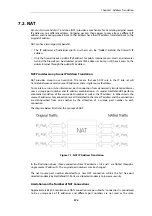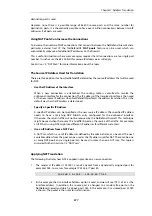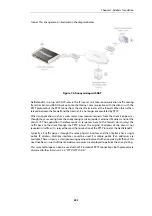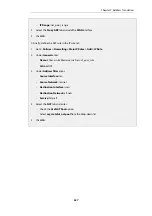
7.2. NAT
Dynamic Network Address Translation
(NAT) provides a mechanism for translating original source
IP addresses to a different address. Outgoing packets then appear to come from a different IP
address and incoming packets back to that address have their IP address translated back to the
original IP address.
NAT can have two important benefits:
•
The IP addresses of individual clients and hosts can be "hidden" behind the firewall's IP
address.
•
Only the firewall needs a public IPv4 address for public Internet access. Hosts and networks
behind the firewall can be allocated private IPv4 addresses but can still have access to the
public Internet through the public IPv4 address.
NAT Provides many-to-one IP Address Translation
NAT provides
many-to-one translation
. This means that each
NAT
rule in the IP rule set will
translate between several source IP addresses and a single source IP address.
To maintain session state information, each connection from dynamically translated addresses
uses a unique port number and IP address combination as its sender. NetDefendOS performs
automatic translation of the source port number as well as the IP address. In other words, the
source IP addresses for connections are all translated to the same IP address and the connections
are distinguished from one another by the allocation of a unique port number to each
connection.
The diagram below illustrates the concept of NAT.
Figure 7.1. NAT IP Address Translation
In the illustration above, three connections from IP addresses
A
,
B
and
C
are NATed through a
single source IP address
N
. The original port numbers are also changed.
The next source port number allocated for a new NAT connection will be the first free port
selected randomly by NetDefendOS. Ports are allocated randomly to increase security.
Limitations on the Number of NAT Connections
Approximately 64,500 simultaneous NAT connections are possible if a "connection" is considered
to be a unique pair of IP addresses and different port numbers are not used or the same
Chapter 7: Address Translation
576
Summary of Contents for NetDefendOS
Page 30: ...Figure 1 3 Packet Flow Schematic Part III Chapter 1 NetDefendOS Overview 30 ...
Page 32: ...Chapter 1 NetDefendOS Overview 32 ...
Page 144: ...Chapter 2 Management and Maintenance 144 ...
Page 284: ...Chapter 3 Fundamentals 284 ...
Page 392: ...Chapter 4 Routing 392 ...
Page 419: ... Host 2001 DB8 1 MAC 00 90 12 13 14 15 5 Click OK Chapter 5 DHCP Services 419 ...
Page 420: ...Chapter 5 DHCP Services 420 ...
Page 573: ...Chapter 6 Security Mechanisms 573 ...
Page 607: ...Chapter 7 Address Translation 607 ...
Page 666: ...Chapter 8 User Authentication 666 ...
Page 775: ...Chapter 9 VPN 775 ...
Page 819: ...Chapter 10 Traffic Management 819 ...
Page 842: ...Chapter 11 High Availability 842 ...
Page 866: ...Default Enabled Chapter 13 Advanced Settings 866 ...
Page 879: ...Chapter 13 Advanced Settings 879 ...





































